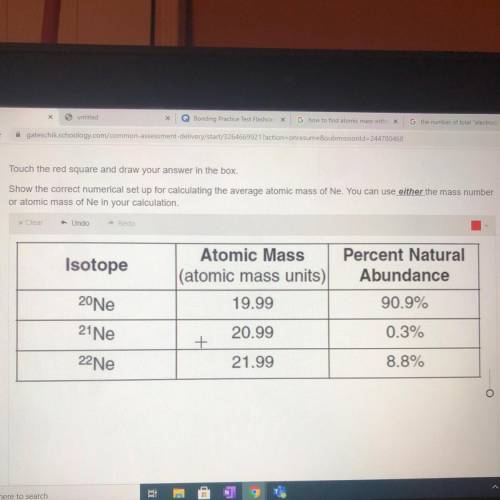
Chemistry, 30.10.2020 16:40 jessixa897192
Touch the red square and draw your answer in the box.
Show the correct numerical set up for calculating the average atomic mass of Ne. You can use either the mass number
or atomic mass of Ne in your calculation.
x Clear Undo - Red
Isotope
Atomic Mass
(atomic mass units)
Percent Natural
Abundance
20Ne
19.99
90.9%
20.99
0.3%
21 Ne
22 Ne
+
21.99
8.8%


Answers: 2


Another question on Chemistry

Chemistry, 22.06.2019 06:00
Oxidation-reduction reactions (often called "redox" for short) are reactions that involve the transfer of electrons from one species to another. oxidation states, or oxidation numbers, allow chemists to keep track of these electron transfers. in general, one element will lose electrons (oxidation), with the result that it will increase in oxidation number, and another element will gain electrons (reduction), thereby decreasing in oxidation number. the species that is oxidized is called the reducing agent or reductant. the species that is reduced is called the oxidizing agent or oxidant. to sum up: oxidation = increase in oxidation state = loss of electrons = reducing agent reduction = decrease in oxidation state = gain of electrons = oxidizing agent part a which element is oxidized in this reaction? fe2o3+3co→2fe+3co2 enter the elemental symbol. view available hint(s) is oxidized part b which element is reduced in this reaction? 2hcl+2kmno4+3h2c2o4→6co2+2mno2+2kcl+4h2o enter the elemental symbol. view available hint(s) is reduced
Answers: 1

Chemistry, 22.06.2019 12:30
Clyde and marilyn are riding a roller coaster. during which section(s) of the track is their potential energy converted to kinetic energy? a. from point b to point c only b. from point b to point d only c. from point a to point b only d. from point a to point b and from point c to point d
Answers: 1

Chemistry, 22.06.2019 14:50
Consider the following multistep reaction: a b→ab(slow) a ab→a2b(fast)−−−−−−−−−−−−−−−−− 2a b→a2b(overall) based on this mechanism, determine the rate law for the overall reaction. express your answer in standard masteringchemistry format. for example, if the rate law is k[a]3[b]2 type k*[a]^3*[b]^2
Answers: 3

Chemistry, 22.06.2019 22:30
What is a number added in front of a formula in order to balance the equation
Answers: 1
You know the right answer?
Touch the red square and draw your answer in the box.
Show the correct numerical set up for calcula...
Questions

English, 27.08.2019 03:30






World Languages, 27.08.2019 03:30


Mathematics, 27.08.2019 03:30

Health, 27.08.2019 03:30

Mathematics, 27.08.2019 03:30

Mathematics, 27.08.2019 03:30


Mathematics, 27.08.2019 03:30

Health, 27.08.2019 03:30

Health, 27.08.2019 03:30


Mathematics, 27.08.2019 03:30


History, 27.08.2019 03:30



